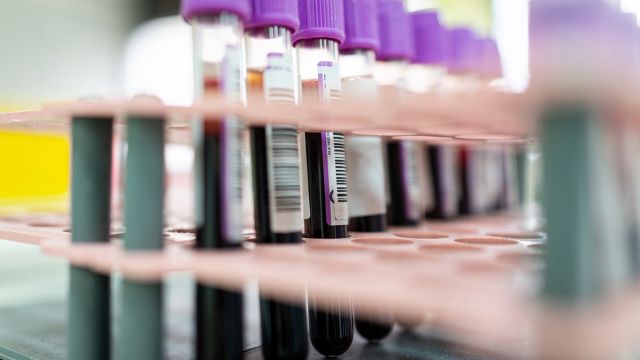Updated on July 23, 2024
Although there are many varieties of cancer, all cancers begin in roughly the same way—with mutated cells that reproduce at an accelerated rate and/or survive for long periods of time without expiring. Cancers are usually categorized by the location in the body where these mutations begin. Lung cancers begin in the cells of the lungs. Breast cancer begins in breast tissue. Colorectal cancer begins in the cells and tissues that make up the colon and rectum.
“Blood cancers” refer to cancers that begin in the cells that produce blood cells, including red blood cells and white blood cells. They are also known as hematologic cancers. The most common blood cancers begin in the bone marrow, with mutations that occur inside the tissues that produce white blood cells.
What are the most common types of blood cancer?
The three main types of blood cancers are leukemias, lymphomas, and myelomas. Each varies in the type of cell where they originate and the symptoms they can cause. There are also multiple subtypes within each.
Leukemias
Leukemias begin in the blood-producing tissues of the bone marrow, when white blood cells (lymphocytes) or cells that mature into blood cells (myeloid cells) become cancerous. As the cancerous cells reproduce and accumulate in the blood and bone marrow, it can affect the immune system, the blood, and the bones. Symptoms can vary depending on the type of leukemia, but can include:
- Fatigue
- Unexplained weight loss
- Frequent and/or severe infections
- Fevers and night sweats
- Bruising and bleeding (such as bruising easily, frequent nosebleeds, or bleeding excessively from a minor wound)
- Swollen lymph nodes
- Joint pain
- Bone pain and/or fractures
Acute leukemias progress rapidly, while chronic leukemias progress slowly over a long period of time. The four main types of leukemia are:
- Acute Lymphoblastic Leukemia (ALL)
- Acute Myeloid Leukemia (AML)
- Chronic Lymphocytic Leukemia (CLL)
- Chronic Myeloid Leukemia (CML)
Lymphomas
Lymphomas are cancers that begin in the lymphatic system. The lymphatic system (or lymph system) is a network of vessels, nodes, organs, and tissues that help the body fight infections, balance fluid levels, and remove harmful or unneeded substances. It is an essential part of the immune system. As lymphoma cells increase in number, they can form tumors in lymph nodes and other locations, damaging the lymphatic system. Symptoms can vary depending on the type, but can include:
- Swollen lymph nodes, especially in the neck, armpits, and groin
- Fever and night sweats
- Fatigue
- Unexplained weight loss
- Respiratory problems, such as coughing or shortness of breath
- Itching
Lymphomas are categorized into two main categories, Hodgkin lymphoma and non-Hodgkin lymphoma. Non-Hodgkin lymphomas are more common, and there are a greater number of subtypes. Hodgkin lymphomas are defined by the presence of large cancerous cells—either Reed-Sternberg cells or Hodgkin cells. Hodgkin and non-Hodgkin lymphomas also follow different disease courses and require different approaches to treatment.
Myelomas
Myelomas are cancers that originate with plasma cells, a type of white blood cell. Plasma cells produce antibodies, proteins that attach to harmful substances (such as a virus or chemical that has made its way into the body). Antibodies act as markers, telling the immune system what to destroy.
Myelomas interfere with the immune system’s ability to fight infections and disease, and also create abnormal antibodies that can cause damage to the kidneys, the bones, and the production of healthy white and red blood cells.
Symptoms of myelomas can include:
- Fatigue
- Bone pain and/or fractures
- Low blood cell counts, including low counts of red blood cells, white blood cells, and platelets
- Blood that is too thick (hyperviscosity)
- Frequent or severe infections
- Kidney problems, which can cause swelling in the legs, itching, and shortness of breath
- High calcium levels (hypercalcemia), which can cause extreme thirst, frequent urination, constipation, dehydration, and abdominal pain
- Damage to the spine and nervous system, which can cause back pain, numbness, muscle weakness, and “pins and needles” sensations
Can blood cancers involve red blood cells?
Leukemias, lymphomas, and myelomas are considered the main types of blood cancer, and all three involve white blood cells. But there are cancers that originate with red blood cells as well. One example is a type of blood cancer called polycythemia vera, which causes an overproduction of red blood cells. Another is essential thrombocythemia, which causes an overproduction of platelets (blood cell fragments that form clots and stop bleeding).
A healthcare provider will always be your best source of information about any unexplained symptom, the risk of blood cancer (or other diseases), and any health concerns you have. While everyone’s health is different, early diagnosis and treatment are always recommended. If you have a concern or are experiencing a symptom, see a healthcare provider.



